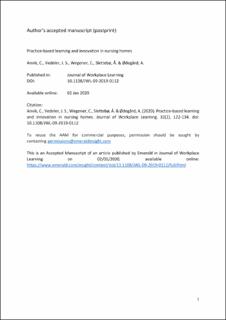| dc.contributor.author | Anvik, Cecilie Høj | |
| dc.contributor.author | Vedeler, Janikke Solstad | |
| dc.contributor.author | Wegener, Charlotte | |
| dc.contributor.author | Slettebø, Åshild | |
| dc.contributor.author | Ødegård, Atle | |
| dc.date.accessioned | 2020-12-04T12:59:32Z | |
| dc.date.available | 2020-12-04T12:59:32Z | |
| dc.date.created | 2019-11-22T09:17:36Z | |
| dc.date.issued | 2020 | |
| dc.identifier.citation | Anvik, C., Vedeler, J. S., Wegener, C., Slettebø, Å. & Ødegård, A. (2020). Practice-based learning and innovation in nursing homes. Journal of Workplace Learning, 32(2), 122-134. doi: | en_US |
| dc.identifier.issn | 1758-7859 | |
| dc.identifier.uri | https://hdl.handle.net/11250/2711971 | |
| dc.description | Author's accepted version (postprint). | |
| dc.description | This is an Accepted Manuscript of an article published by Emerald in Journal of Workplace Learning on 2 Jan. 2020. | |
| dc.description | Available online: https://www.emerald.com/insight/content/doi/10.1108/JWL-09-2019-0112/full/html | |
| dc.description.abstract | Purpose: This article investigates the conditions under which learning and innovation occur within nursing homes. It addresses the interplay between formal and informal learning situations and discusses how these processes facilitate individual staff and workplaces’ capacity for innovation. Design/methodology/approach: Data was produced via fieldwork, which included participant observations, conversations, and research interviews with staff and managers at a Norwegian nursing home. The article is inspired by situated learning theories and communities of practice, as the social context emerges as the site where learning and innovation are cultivated. Findings: The nursing home sustains a learning environment through managers and staff’s participation in planned learning situations and thereby highlights a focus on learning in their everyday practices. The conditions for the interplay between planned learning situations and everyday learning practices are identified as the effort to create a “joint enterprise” and reflexive practices. Social implications: The Global North is aging. Consequently, there is an increasing need for facilities and adequately trained professionals to support an aging population. Addressing these challenges will require an increased focus on developing supportive learning environments and furthering our knowledge about the interconnections between learning processes and innovation. Value: This article contributes knowledge regarding nursing homes as professionally exciting places to work. Additionally, it points out conditions that allow for learning and innovation to be cultivated and thereby increase the quality of elderly healthcare services provided. Keywords: innovation, learning, workplace, competence, nursing homes | en_US |
| dc.language.iso | eng | en_US |
| dc.publisher | Emerald | en_US |
| dc.rights | Navngivelse-Ikkekommersiell 4.0 Internasjonal | * |
| dc.rights.uri | http://creativecommons.org/licenses/by-nc/4.0/deed.no | * |
| dc.title | Practice-based learning and innovation in nursing homes | en_US |
| dc.type | Peer reviewed | en_US |
| dc.type | Journal article | en_US |
| dc.description.version | acceptedVersion | en_US |
| dc.subject.nsi | VDP::Medisinske Fag: 700::Helsefag: 800::Helsetjeneste- og helseadministrasjonsforskning: 806 | en_US |
| dc.subject.nsi | VDP::Samfunnsvitenskap: 200::Sosiologi: 220 | en_US |
| dc.source.pagenumber | 122-134 | en_US |
| dc.source.volume | 32 | en_US |
| dc.source.journal | Journal of Workplace Learning | en_US |
| dc.source.issue | 2 | en_US |
| dc.identifier.doi | 10.1108/JWL-09-2019-0112 | |
| dc.identifier.cristin | 1750794 | |

